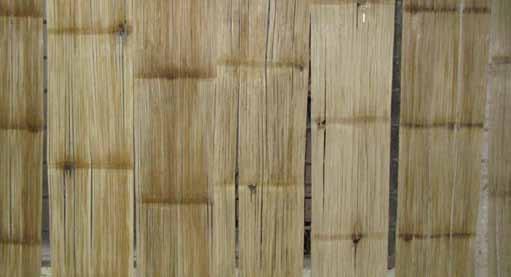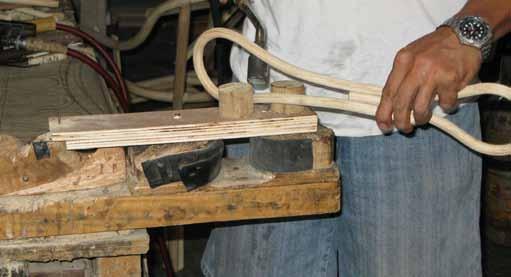
5 minute read
OPPORTUNITIES AND CONSTRAINTS
2.3 Opportunities and Constraints in the Rattan and Bamboo Value Chains
Rattan
Advertisement
Opportunities Despite depressed global markets and prices for rattan furniture products, stakeholders in the rattan value chain were still optimistic about rattan production, having identified the following as the potential prospects in engaging in this sub-sector:

Rattan can be harnessed in the gifts, decors and houseware (GDH) sector, so the industry can still potentially add to the incomes of the operators in the rattan value chain; and
There is an abundance of raw materials for furniture making. Wide areas can be planted with rattan and there is no apparent lack of planting materials as there are wildlings that are readily available.
Constraints
The permitting system for harvesting rattan is complex and sometimes
cumbersome. This makes compliance difficult, and could even be prone to errors or varying interpretation by officials tasked with evaluating and approving permit applications. This could lead to even more price distortion.
Rattan is not considered a priority industry sector and therefore, those engaged in the industry could not get enough attention or support from appropriate agencies. There were no new programs designed or currently implemented to improve the performance of the rattan industry. Rattan was not included in the Department of Trade and Industries’
list of primary commodities to be developed and supported. The commodities that are the focus of research and development efforts in Region 8 include coconut, abaca, and jackfruit, but not rattan nor bamboo.
The low price for rattan that is almost being unilaterally imposed by traders/
buyers of these products. Farmers do not consider such a low price as fair return for their labor after investing considerable time and effort to bring rattan canes down from the forests where they are gathered.

There is lack of access to product development. They feel it makes it even more difficult for them to compete given the lack of modern facilities and other factors that make their products outdated and more expensive than what foreign competitors could offer. Processors also consider as a constraint their inability to access the latest rattan processing technologies, such as in the drying and treatment of rattan poles. They also find the industry as lacking in appropriate tools and equipment and skilled workers. The market is largely “domestic” (i.e., confined to Leyte), and production volumes are still very low.
While traders believe that there is enough rattan in the Island, the supply of rattan
poles remains unstable. Enablers concede that available harvestable stocks of rattan are still largely an untapped economic resource. One are of development noted by the enablers is the presence of organized POs which they also consider as an opportunity for the rattan value chain. These POs could easily avail of training opportunities provided by various government agencies and development organizations. Leyte is in close proximity to Cebu, a processing center for rattan furniture. Some Cebu manufacturers make use of the so-called “Big Brother” scheme for sub-contracting materials and components needed for their products.
Bamboo Only two POs were engaged in bamboo plantation development in Leyte Island. Others reported to have planted bamboo as hedges or markers along boundaries, or to stabilize the soil along creeks/riverbanks, but not for the purpose of marketing the mature bamboo culms later. If harvested, the bamboos were employed for domestic use or for the consumption of the POs but not for commercial purposes.
Opportunities Notwithstanding the current situation of the bamboo industry in Leyte Island, stakeholders believed that there is potential to engage in bamboo propagation and even up to processing owing to the following:
(1) Sufficiency of bamboo supply in the Island; (2) The potential for new product lines from bamboo such as chopsticks and toothpicks, which makes bamboo a good raw material for gifts, decors, and houseware (GDH) manufacture; and (3) Expectation of high demand for quality bamboo furniture at some periods during the year.
There was general agreement among stakeholders that bamboo remains in abundant supply in Leyte, and could readily feed an industry in need of available raw materials. They found great promise in the GDH sector, where bamboo has potential to be crafted into many types of products that would easily fit into new and emerging consumer demands. Despite seasonal demand for bamboo furniture, stakeholders believe that they can live with it provided they have the resources to meet the demand when it is at its peak. They have well-adapted to the local bamboo furniture market and could even afford to sell their products to walk-in buyers from outside the Island.
Constraints Perceived as constraining the stakeholders from fully-benefiting from the bamboo industry in Leyte were the following: (1) lack of propagation technology that will result in easy to harvest bamboo plantations; (2) lack of buyers resulting in overgrown bamboo poles; (3) lack of drying technology; and (4) and unavailability of capital to acquire modern facilities for bamboo furnituremaking.
Although bamboo grows easily, the absence of proper propagation and management techniques results in dense bamboo clumps that are difficult to access at harvesting time. Also, bamboo is so abundant that most clumps grow beyond maturity. Growing bamboo and maintaining them are of no use to farmers if they could not be exchanged for cash due to the limited number of buyers. The quality of bamboo furniture and bamboo-made products is adversely affected by the moisture in bamboo. If improperly dried, bamboo will deform, crack, and the joints in finished products will become weak. Hence, the absence of drying technology for bamboo poles is seen as a key constraint that must be addressed. Other than drying, there are other technologies that can help upgrade bamboo product quality, but the processors have very limited capital to access them. Even the facilities that were promised to them in order that they could expand their operations and improve the marketing of their products were not properly installed because of the limited funds provided for the project.




